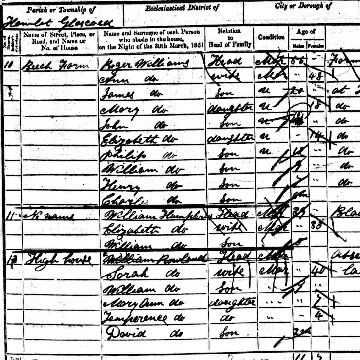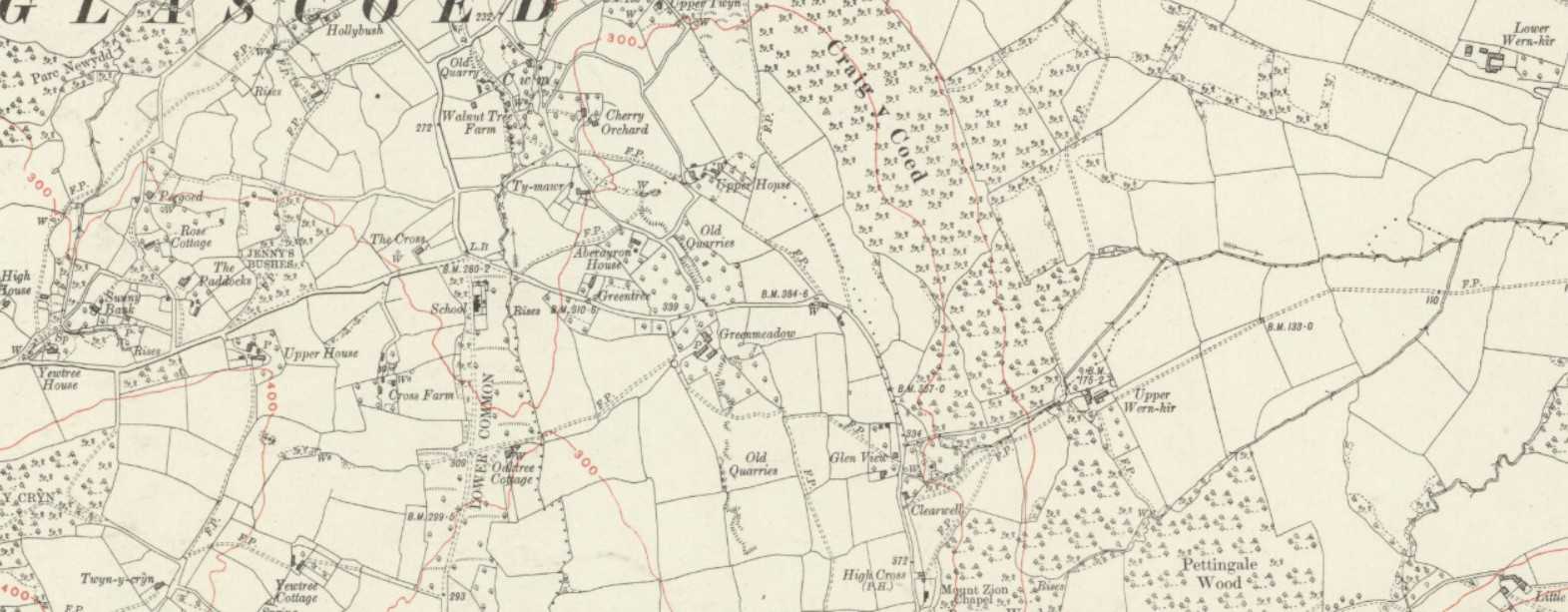Overview
Lower Wernhir was probably built in the late 16th or early 17th century. It was just on the edge of Glascoed’s borders with Llanbaddock and Monkswood.
Lower Wernhir’s former location is on the site of the Modern day Royal Ordnance Factory, Glascoed. It was one of two farmhouses that were destroyed in the construction of the factory. Apparently they were photographed before destruction, so all is not lost! I’d love to see these photos. So far I have only been able to view Upper Wernhir’s photographs.
Facts and Figures

Year of Construction
Late 16th or early 17th century (Estimated).

First Recorded Residents and year
Possibly William Lloyd in 1806. Land Tax assessments place William Williams and his wife Ann at "Wern hire Farm" in 1823 and 1824, although we may have the wrong Wernhir farm!

Residents at time of the 1851 census
Reece and Elizabeth Evans.
Location
Lower Wernhir’s site is now on the BAE Glascoed munitions factory site, having been demolished to make way for the factory in the 1930s. I have added a marker which approximates where Lower Wernhir was situated, having checked the “Old maps” reproduced at the start of this page.
Residents
Lower Wernhir was obviously the home of many people in its 350 year existence, and through the 19th century censuses we have been given information on a selection of them. Here are some things that I have been able to glean about the inhabitants.
The problem with the first few entries is that there were three Wernhir properties in the vicinity, and it difficult to say whether the house referred to as “Wern hire farm” is Upper Wernhir, Lower Wernhir or even Middle Wernhir.
I have assumed that it refers to “Lower Wernhir” since that lay within Glascoed’s boundaries, although it is quite possible that the reference is for Upper or Little/ Middle Wernhir. Please read the “William Lloyd” and “William and Ann Williams” entries with some caution.
Did William Lloyd live here in 1806?
By tracing back and matching Land Tax Assessments from earlier years, I have concluded that the likely resident of Lower Wernhir in 1806 would have been William Lloyd. This is based on the property he was living at being valued at exactly £18. Lower Wernhir was the only property valued at this rate or within £3 of it on later Land Tax Assessments. This could obviously be a wrong assumption!
1820s and 1830s: William and Ann Williams
The Land Tax Assessments point to a William Williams being the Head of Household at the time of the 1823 Land Tax Assessment records. He must have died shortly afterwards, since on the 1824, 1829 and 1831 records for Lower Wernhir, Ann Williams (Widow) was the Head of Household. I don’t actually know any more about this couple at this point. Any help will be much appreciated!
1841: Daniel and Sarah Roberts and family
The Roberts family appeared on the 1841 census. Daniel Roberts was a Farmer and was the Head of the family (aged approx 40). Sarah his wife was some 15 years his junior. Her maiden name was Evans and she was from Llanvetherine. Their children, Edwin, aged 10, Marian, aged 7, William aged 4 and Sarah aged 1 were the other people named Roberts in habitation at this time.
The family were linked to Mount Zion Baptist Chapel, in Glascoed. A William Roberts (possibly Daniel’s brother) trained at the Baptist Academy – unfortunately with indifferent results (see link). He was one of the early deacons of the chapel and died in Abergavenny in 1837/8, having never quite becoming established as a pastor. He was apparently involved in a coal delivery business at Abergavenny.
The Roberts family were still at Lower Wernhir in the late 1840s, according to the 1848-49 Register of Electors. Even though the census of 1851 has the Roberts family at Hendre Farm,Llanbaddock, the 1853-54 Register of Electors still has Daniel Roberts using Lower Wernhir as his qualification to vote, so perhaps he sub-let Lower Wernhir to the next residents.
Upstairs, downstairs!
Also living at the farm in 1841 were Henry Watkins (age approx 20), an agricultural labourer, and three servants, Henry Evans (also aged approx 20), Maria Jenkins (aged approx 15) and Ann Matthews (age 10).
It appears that love and a marriage followed involving two of those “downstairs”! Henry Watkins and Maria Jenkins appear on the 1851 census as a married couple at another Glascoed house, “Pergoed”.
By now, Henry was a farmer in his own right at Pergoed. It appears that the Henry Watkins of Lower Wernhir in 1841 married Maria Jenkins his fellow servant. Henry and Maria married on 20th March 1846 at Llanddewi Fach Parish Church – so there must have been love in the air at Lower Wernhir! They lived long and fruitful lives – both died at the ripe old age of 87 and were buried at Mount Zion Baptist Chapel in Glascoed.
1851: Reece and Elizabeth Evans: Temporary Stewards.
The Roberts family had left Glascoed for Llanbadock by the time of the 1851 census. In their place, we find an older couple at Lower Wernhir on census night 1851: Reece and Elizabeth Evans. Reece was a 55 year old labourer who hailed from “Langattock” in Carmarthenshire, according to the enumerator. This was probably Llangadog in Carmarthenshire. Elizabeth was his junior by nine years and was born in Caerleon, Monmouthshire. Reece and Elizabeth stayed in the area, living on Pontypool Road, Monkswood in 1861 and at a cottage in Monkswood in 1871.
The Rees family
The 1855 to 56 Register of Electors has a Leonard Rees in “occupation of house and land” at Lower Wernhir. He hailed from Llansoy in Monmouthshire. His wife Mary (nee Morgan) was about 15 years his junior and was his second wife. She was born in Penrhos and had married Leonard in Llanellen, Monmouthshire on 6th May 1832.
Leonard Reece’s obituary in the Usk Gleaner, in 1858 notes Wernhir as his residence and his age as 71. He actually died on Christmas day. His wife, Mary (nee Morgan) died within a few months of Leonard’s death; on 28th March 1859.
In 1861 Ann Rees, a 65 year old spinster, and Leonard’s sister, was the Head of Household, and was in charge of three nephews and nieces. Ann was born in Llanfihangel Torymynydd, near Raglan. The eldest, Richard Rees, a 31 year old “farmer’s son” was born in Raglan. The other two, Benjamin and Mary Rees (aged 26 and 20 respectively) were born in Llanellen, near Abergavenny. Their occupations were also described as “farmer’s son/ daughter” according to the census enumerator. This may have been easier that writing “farmer’s nephew/ niece” or possibly their dad was a farmer.
Richard Rees married Eliza (maiden name not known) whilst at Lower Wernhir, and their daughter Alice Mary was baptised at Monkswood parish church on St. David’s Day 1868. Both Richard and his Aunt Ann had departed by 1871, and Lower Wernhir had been taken over by the newly married Benjamin, Ann’s nephew. Richard and Eliza had moved to the neighbouring Bryn Farm.
Benjamin was born in 1834 at Llanellen, the son of Leonard and Mary Rees (nee Morgan). He was married to Catherine, who hailed from Llangattock in Breconshire. They had several children whilst at Glascoed, including Mary Ann, William, Leonard Lewis, Tom Benjamin and Elizabeth Jane. They had their children baptised at Monkswood Parish Church. The church was also the scene of some sadder occasions in the 1870s when they buried their infant daughter Elizabeth Jane on 16/08/1876. She was aged just 4 months.
They had left Glascoed by 1879. Rees family folklore relates that the family farm had to be sold in order to pay death duties for a family member who was in Australia. This has not been fully verified at this point. The family settled in Bootle, having moved there via Gloucester, where another son, John, was born in 1879. They also had a daughter named Temperance, who was born in Bootle in 1883.
One of Benjamin’s descendants shared some images of the family Bible that Benjamin were recorded his family tree. You can view these in the Family bibles and family trees section of this website.
The Chilton family
were in residence by 1879 according to the Register of Electors.
The Head of the family was William Chilton. William was born in 1830 at Nantyglo, (Aberystruth parish) in Monmouthshire, and was noted as a farmer. His wife, Mary Morris, was born in Llanelly, Breconshire c. 1836. They had two children living with them at Lower Wernhir in 1881; Mary and Solomon Chilton. Mary had been born at Llangattock, Breconshire in about 1862 and Solomon was born one year later at Aberystruth. One can assume that there may could have been some sort of connection between the Chiltons and the previous residents, the Rees family, since Catherine Rees had been born in Llangattock also. Obviously, assumptions can often be very dangerous in genealogy! Other people at Lower Wernhir at the time of the 1881 census were Mary Bush, a 46 year old friend (likely William’s sister) from Aberystruth, George Waters, a 23 year old indoor servant and a 5 year old visitor, Miney Davis. Mary Bush was living with the Chiltons, having recently separated from her husband.
The family moved to Middle Wernhir around 1883 or 1884 and stayed there for a couple of years. Following this they moved to Trostrey parish, before settling back at Mary’s home area of Llanelly, Breconshire. Mary died in 1897. In 1901, William, a widower in his early 70s, was farming at Tyn-y-coed, Llanelly. By 1911, his son Solomon and Solomon’s wife, Rebecca had joined William at Tyn-y-coed. Solomon along with his 16-year-old son, William Solomon Chilton was running the farm.
Solomon sadly died before his father in October 1911 at Tyn-y-coed. William Chilton died in 1914 at Tyn-y-coed, Llanelly.
The Jones family
Thomas Jones appeared on the Electoral Roll in 1889. The Jones family were still at the farm for the 1891 and 1901 censuses. From the birthplaces and ages of their children on the censuses, it appears that they arrived in Glascoed in about 1885 (probably taking up residence at Lower Wernhir at this point). Both Thomas and Ann Jones were born in Clodock, Herefordshire c. 1855. They had five children living with them at the time of the 1891 census; Annie Beatrice, Emily, Jane, Philip and Kate. Annie and Jane had moved on by the time of the 1901 census. A James Pitt was working as their agricultural labourer in 1891 (born in Herefordshire, c. 1866). Another Herefordshire native, Samuel Long was their Carter in 1901. Samuel was also from Clodock, born c. 1872.
William Edwards
William Edwards was on the Electoral Roll at Lower Wernhir in 1909. And was still there for the 1911 census. He was a farmer from Lisvane, Glamorgan, born around 1853 and was married to Rachel, who had been born cir 1852 at Mynyddislwyn, Monmouthshire. They had been married in about 1877/78 and had 8 children, four of whom were still with their parents at Lower Wernhir on the 1911 census.
Richard Henry and Florence Gertrude Williams
The 1921 census reveals a rather full Lower Wernhir. Richard and Florence were from families with strong Glascoed roots – Richard was part of the Williams family of Beech Farm and the son of Philip Williams and Anne (nee Gwatkin). He was born on 10th December 1887 at Beech Farm.
Florence was born at Walnut Tree Farm in nearby Monkswood, the daughter of Thomas William and Hannah Alice Crump. The Crumps don’t feature in great detail on this website yet, although I know that they had strong Glascoed links.
They had five children between the ages of 9 months and 6 years old: Gertrude Kate, Florence Mary, Percy Crump, Ruby Helena, Richard Crump and Elizabeth Mary Ann – all surnamed Williams.
Three servants were also in residence: Elizabeth Mary Ann Dibble, a 25 year old House servant from Old Furnace, Pontypool; Bert J. Callow a 29 year old cowman from Bow Mill Farm, Allington, Devon and Wilfred Topham, a 14 year old agricultural labourer from Abergavenny.
The 1922 Register shows Richard and Florence as voters. Bertram Carllow and Frederick Johnson were also registered to vote.
William Henry and Emily Williams
William Henry Williams was the son of Henry Williams, of Bryn Farm, Philip Williams’ brother and consequently was the first cousin of the previous resident, Richard Henry Williams. He was married to Emily Williams, who had lived at Pergoed, Glascoed as a small child and later at Upper House, Llanbaddock. They were living there at the time of the 1929 Register of Electors.
I believe that they were the last residents of Lower Wernhir, living there until it was purchased to form the Munitions factory: ROF Glascoed in the late 1930s. They had two boys: Alfred Glyndwr Williams, born in 1922 (who wrote the marvellous history of Mount Zion Baptist Chapel) and Merfyn, born in 1924.
Records
Land Tax Assessments
1806 – William Lloyd was the likely resident of Lower Wernhir.
1823 – William Williams
1824, 1829 and 1831 – Ann Williams.
Censuses:
1841 – Daniel and Sarah Roberts.
1851 – Reece and Elizabeth Evans.
1861 – Ann Rees.
1871 – Benjamin Rees.
1881 – William Chilton.
1891, 1901 – Thomas Jones.
1911 – William Edwards.
1921 – Richard Henry and Florence Gertrude Williams.
Registers of Electors
1843-44, 1848-49, 1852-53, 1853-54 – Daniel Roberts.
1855-56 – Leonard Reece.
1868-70, 1870, 1871, 1872, 1874, 1875, 1876 – Benjamin Rees.
1879 – William Chilton.
1889 – Thomas Jones.
1909 – William Edwards.
1922 – Richard Henry Williams, Florence Gertrude Williams. Also Bertram John Carllow and Frederick Johnson.
1929 – William Henry Williams and Emily Williams.



